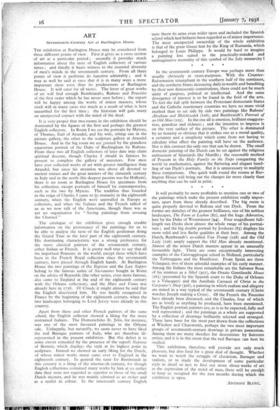ART
Seventeenth-Century Art at Burlington House
Tim exhibition at Burlington House may be considered from three different points of view. First it gives us a cross section of art at a particular period ; secondly it provides much information about the taste of English collectors of various times ; and thirdly it bears witness to the essential diversity of men's minds in the seventeenth century. From all three points of view it performs its function admirably ; and it may as well be said at once that it is in many ways a more important show even than its predecessors at Burlington House. It will cater for all tastes. The lover of great works of art will find enough Rembrandts, Rubens and Poussins of the first order which he has never seen before ; the expert will be happy among the works of minor masters, whose stock will in many cases rise much as a result of what is here unearthed for the first time ; the historian will gain many an unexpected contact with the mind of the dead.
It is very proper that two rooms in the exhibition should be dominated by the figures of the first and perhaps the greatest English collectors. In Room I we see the portraits by Mytens, of Thomas, Earl of Arundel, and his wife, sitting one in the picture gallery, the other in the sculpture gallery at Arundel House. And in the big room we are greeted by the grandiose equestrian portrait of the Duke of Buckingham by Rubens. From these two all English collectors of later date may claim spiritual descent, though Charles I should in fairness be present to complete the gallery of ancestors. Few men have ever collected works of art with greater intelligence than Arundel, but since his attention was above all devoted to ancient statues and the great masters of the sixteenth century in Italy and in the north (his deepest passion was for Holbein), there is no room at Burlington House for specimens from his collection, except portraits of himself by contemporaries, such as the two by Mytens. The tradition thus founded in the reign of Charles I came to. its maturity in the eighteenth century, when the English were unrivalled in Europe as collectors, and when the Italians and the French talked of us as we now talk of the Americans, though there was as yet no organisation for " Saving paintings from crossing the Channel."
The catalogue of the exhibition gives enough erudite information on the provenance of the paintings for us to be able to analyse the taste of the English gentleman doing the Grand Tour in the later part of the eighteenth century. His dominating characteristic was a strong preference for the more classical painters of the seventeenth century, either Italian or French. It is pretty well true to say that all the important Poussins in the world, except those which have been in the French Royal collection since the seventeenth century, have passed through English hands. At Burlington House the two paintings of the Baptism and the Last Supper belong to the famous series of Sacraments bought in Rome on the advice of Reynolds (the other series, even more famous, also came to England at the end of the eighteenth century with the Orleans collection), and the Mars and Venus was already here in 1758. Of Claude it might almost be said that the English discovered him. He was hardly recognised in France by the beginning of the eighteenth century, when the two landscapes belonging to Lord Jersey were already in this country.
Apart from these and other French painters of the same School, the English collector showed a liking for the, more restrained Italians. The Domenichino St. John, for instance, was one of the most favoured paintings in the Orleans sale. Unhappily, but naturally, we seem never to have liked the real Baroque painters of Italy, who are therefore ill- represented in the present exhibition. But this defect is to some extent remedied by the presence of the superb Neptune of Bernini, which displays the style at its highest point in sculpture. Instead we showed an early liking for the Dutch, of whose minor works many came over to England in the eighteenth century. In general the taste for Rembrandt in this country is a thing of the nineteenth century, for though English collections contained many works by him at an earlier date they were not regarded as superior to those of the small Dutch masters, and he was mainly admired as an etcher and as a realist in colour. In the nineteenth century English
taste threw its arms even wider open and included the Spanish school which had hitherto been regarded as of minor importance. The most unexpected ownership of the whole exhibition is that of the great Greco lent by the King of Rumania, which belonged to Louis Philippe. It would be hard to imagine a painting less suited to the practically-minded and unimaginative mentality of this symbol of the July monarchy I * * * *









































 Previous page
Previous page